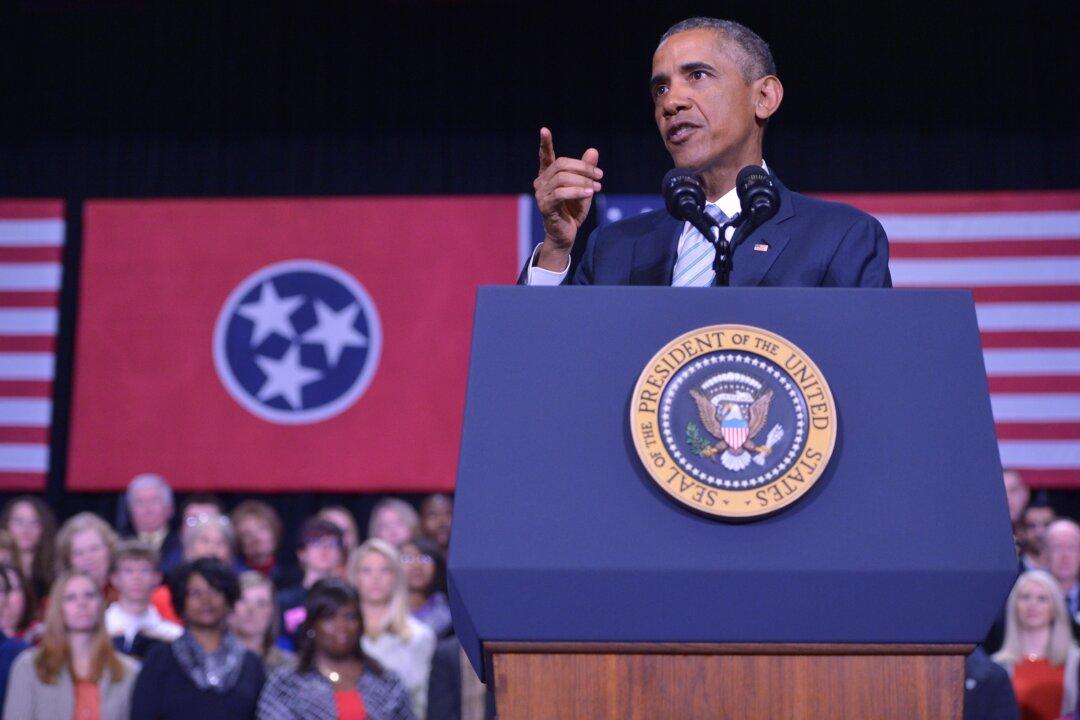President Obama can’t resist the temptation to gin up new entitlements that chase votes but make problems worse. Free tuition at community colleges would be no exception.
The president proposes to offer states 75 percent in matching federal money to refund tuition. Community colleges would have to offer programs that permit students to either transfer to four-year colleges with half the credits needed for a bachelor’s degree or award a vocational certificate in demand by employers. Students would have to maintain a C average.
That would simply pour money onto failing diploma mills. The three-year graduation rate at public two-year institutions is 21 percent, which is about one-third the rate for two-year nonprofit and for-profit schools, and much less than the 59 percent six-year graduation rate at four-year institutions.
Many community colleges do provide good job training in areas such as nursing, information technology, and security. However, too many have been starved for funds as states have devoted more resources to K–12 education and entitlements such as Medicaid. And community colleges are staffed by bureaucrats, who too often are not particularly adroit at identifying private-sector needs and fashioning classrooms to jobs programs.
Too many students are ushered into programs that are less expensive to staff and that are aimed at transferring students into four-year colleges. The standards are often not high enough.
Many state universities are required to honor credits awarded at community colleges when the course numbers match up, but many transfer students are simply not competitive. Colleges either must create special programs to accommodate them or professors must look the other way and award passing grades for quite marginal work, and less.
Top students at universities such as mine—as measured by graduate-school entrance tests and performance—-are as well educated as most Ivy League students, but processing too many community-college transfers depreciates the value of our diplomas.
Community colleges admit too many students with deficient high school records and preparation, intractable personal problems, and poor study habits and executive skills.
Marginal students—for example, those with a gap in math, writing, or study skills—can be helped. Remedial programs and counseling, however, won’t do much for a 19-year-old mother who receives no child support, reads at the sixth-grade level, can’t do algebra, and has significant emotional and self-esteem issues. Yet, that is exactly who the president proposes to send to college.
Too many job seekers don’t have the skills businesses need and pushing more dysfunctional students into community college won’t help.
Starved for funds, those institutions will simply game the system by enrolling more students in programs aimed at transferring to four-year colleges and awarding more B’s and C’s in watered-down courses. Universities such as mine will face enormous political pressure from “progressive” state lawmakers to accept the transfers, award questionable degrees, and generally join in the fraud.
Historically, some of the best jobs training programs have been offered by businesses through industry apprenticeship programs, most notably in manufacturing and construction. However, buffeted by the Great Recession and tough competition from Asia, those have dwindled and businesses increasingly expect community colleges to perform in ways they can’t.
Less noticed in the president’s proposal is an American Technical Training Fund that would subsidize partnerships between businesses and community colleges and private training institutions that demonstrate they move students from classrooms into good jobs.
Such hands-on programs are often more helpful to students with spotty high school records. Those have more structure and don’t require students to write essays about Chaucer or affirm a left-wing professor’s feminist critique of capitalism. They simply impart skills.
Rather than expanding useless liberal arts programs, ATTF grants could improve the quality of what goes on in both community colleges and private training institutions at a lot less cost.
America doesn’t need any more bogus bachelor degrees in art history, but it could sure use a few more welders.
Peter Morici, professor at the Robert H. Smith School of Business at the University of Maryland, is a recognized expert on economic policy and international economics. Previously he served as director of the Office of Economics at the U.S. International Trade Commission. Follow @pmorici1





